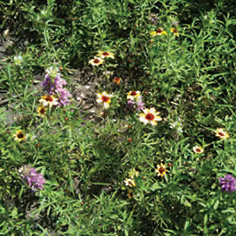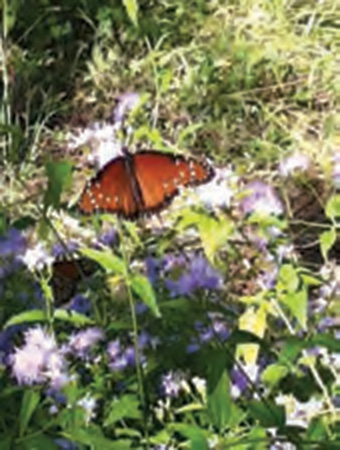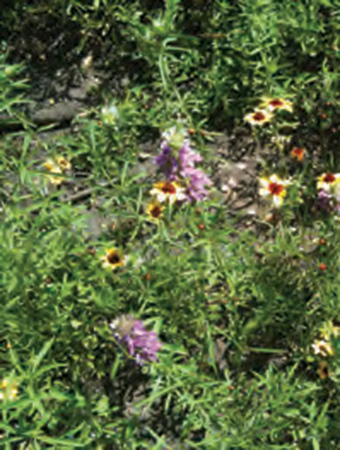
The Story
Casis School opened in 1951 on its current campus. The unused land at the west side of the building lot was undeveloped and was used for drainage into Taylor Slough and to dump leftover construction material . Signs of early Texans abounded. Before the fifth grade wing was built and the fill dumped into the forest, Casis students and University of Texas researchers could find artifacts of early Indians.
Around 1980, playground equipment was installed. Over the years, donations included: two wooden bridges, the red plant identification station, the entrance sign, the animal tracks mosaic and volunteers worked to control invasive plant species.
By 2011, most of the annual care and maintenance had been neglected and the Forest was in bad shape. This resulted in little plant life except the mature trees and invasive species, no native understory and almost no animal life. Because of bad erosion, soil compaction, and drought, the mature trees were dying - almost all of the forest on the south side and about half on the other side had died. Finally, restoration efforts began with a $10,000 grant from the PTA and several parent work days. Work focused on controlling erosion, building trails, adding organic material, and removing exotic invasive woody plants.

A PLACE FOR: PLAY
The primary use of the Forest is for free play during school. Teachers may take their classes to the Forest once a week. Kids run wild, far more energetically than they do on a playground. They sit and chat in favorite spots, they go on quiet explorations, build forts and dams, organize games like “Capture the Flag,” They use their imagination. They make discoveries with squeals of delight. There is something magical about playing there.
Ask any Casis student...the Forest is treasured.

A PLACE FOR: LEARNING
The Forest is nature’s classroom. Kids learn cooperative play, science, art, service and engineering with formal and informal lessons from their teachers. PE classes run cross-country; art classes do creative projects, kids in Forest Club work in groups on erosion control and learn plant and bird species. Other classes work together to help make needed improvements. The Chair of the Forest Committee is always available to assist teachers and children in their learning. She particularly enjoys teaching small groups lessons like: how and where to set free a snake, and what plants butterflies prefer.

A PLACE FOR: NATURE WALKS
The Chair of the Forest Committee will take any group on nature walks to discover plants and animals. Teachers and informal groups of children can do the same. Casis has printed field guides that can be used for reference any time. The Forest Club also features specially-lead walks by experts in various fields of nature and forest life.
The Casis Garden Wish List
Donations
- New understory trees and shrubs - buckeye, rough leaf dogwood, wild plum, and others, especially on the west fence (planting/watering and ongoing until established)
- Boulders for erosion control (and installation)
- Durable plaques or markers identifying plants
Labor
- Mulch moving: trails must continually be refreshed (ongoing)
- Fence repair
- Trail building
- Drainage improvements: (east fence and at gate)
Adoption
- Care of existing bird feeders and bird baths (ongoing)
Volunteer Opportunities
We’ve seen what staggering affects happen with neglect. Our Forest offers an abundance of opportunities for volunteer work. They offer something more meaningful than lifting free weights at a gym. This work is for people who love nature and/or children, and for those who need community service hours. We invite you to come get your hands dirty and help our magical sanctuary live for all to enjoy.
Contact the Forest Chair:
Phyllis Schunck (512)472-2086
schunck33@sbcglobal.net
What lives here?
Plant Varieties
The plants have rebounded with the addition of organic material and removal of invasive competitors. They are too numerous to list, but include:
GRASSES: side-oats grama (the State Grass of Texas), brushy bluestem, dallis grass, silver bluestem, Indian grass, curly mesquite, Virginia wild rye, southwest plains bristle grass
FORBS: dayflower, spiderwort, Mexican blanket, bluebonnet, pigeonberry, three-seeded mercury, cucumber weed, lemon mint, snake herb, white petunia, silver puff, Mexican petunia, bundleflower, Zexemia daisy, lantana, corn salad, velvet leaf mallow, golden mallow, bull nettle, noseburn, poison ivy, oxalis
VINES: cowitch, mustang grapes, fox grapes, Virginia creeper, greenbriar, crossvine, Carolina snailseed, bracted passionflower
SHRUBS: elbow bush, blue condalia, cherry laurel, prickly pear, Turk’s cap, nandina (exotic invasive), Chinese photinia (exotic invasive), chile petin, agarita, American beautyberry
TREES: wafer ash, Mexican persimmon, Ashe juniper, cedar elm, hackberry, post oak, live oak, honey mesquite, kidney wood, Texas red oak, palo verde, white mulberry, paper mulberry (exotic invasive), chinaberry(exotic invasive), yaupon holly
Animal Varieties
BIRDS: Red-bellied woodpecker, downy woodpecker, cardinal, western raven, crow, cowbird, great-tailed grackle, white wing dove, Carolina wren, red-tailed hawk, multiple species of warblers, sparrows and finches
REPTILES: rough earth snake, ribbon snake, Texas spiny lizard, Southern plains lizard
MAMMALS: armadillo, raccoon, gray squirrel, red fox
INSECTS: cochineal, native ants and exotic invasive fire ants, multiple species of: flies, moths, beetles, mosquitoes, bees, and butterflies, including Monarch, Queen and Gulf fritillary
Casis Garden Gallery






